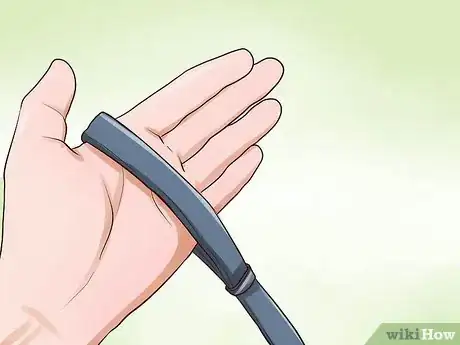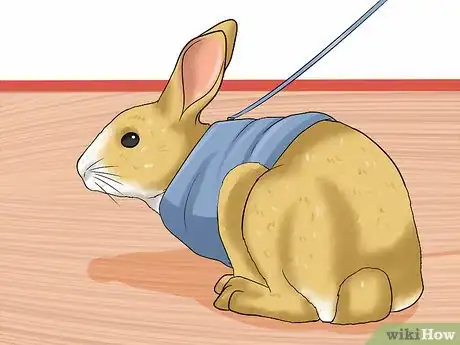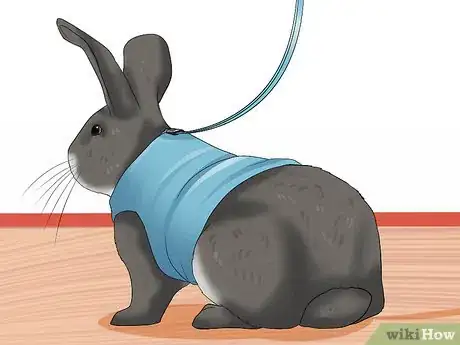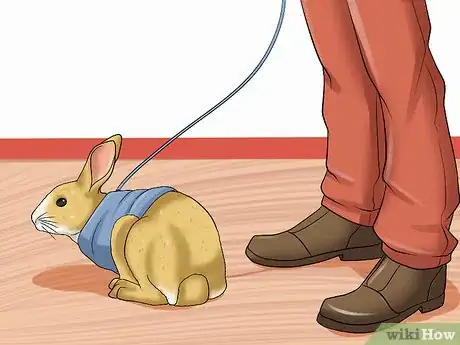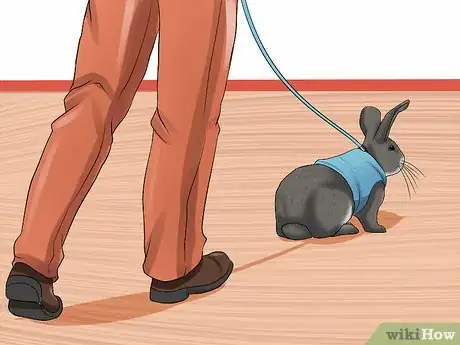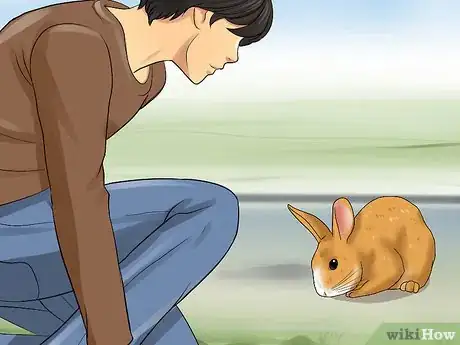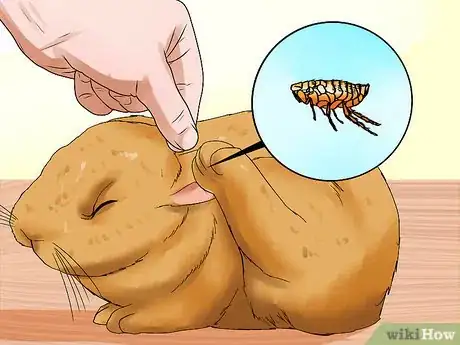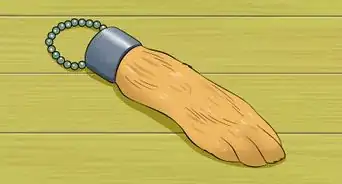This article was co-authored by Pippa Elliott, MRCVS. Dr. Elliott, BVMS, MRCVS is a veterinarian with over 30 years of experience in veterinary surgery and companion animal practice. She graduated from the University of Glasgow in 1987 with a degree in veterinary medicine and surgery. She has worked at the same animal clinic in her hometown for over 20 years.
There are 7 references cited in this article, which can be found at the bottom of the page.
This article has been viewed 106,992 times.
Do you have a rabbit and want to give it some exercise and a change of scenery? Most rabbits get enough exercise through running free in a bunny-proof space, but you can still take your pet for a walk outside of your home. Your rabbit will likely guide you, but this can be an enjoyable time for both of you. You can take your rabbit for a walk by acclimating it to a harness, strolling easily with it, and keeping it safe while you’re out.[1]
Steps
Getting Your Rabbit Used to a Harness
-
1Start with a proper harness. If you plan to take your rabbit outside of your home, you’ll need a leash so that it doesn’t get away. Harness-style leashes are the best option for your bunny because they minimize the risk of discomfort or injury.[2]
- Look for harnesses, which go around your rabbit’s chest and torso, in the rabbit or cat aisles of your local pet store. You want something that is lightweight and no more than 6 feet.[3] Remember that your rabbit will technically be walking you. The harness and lead is simply to give your rabbit a gentle tug if he is going into danger, and to give you a feeling of being in control.
- Try and find an H-style harness, which looks like an H when laid out flat.[4] You can also get a figure-eight style harness, but be aware that there isn’t a consensus on whether they’re safe. These style harnesses can cinch your rabbit’s neck and cause injury.
- Avoid collar leashes because your rabbit can easily slip out of them or get injured.
-
2Fit the harness on your rabbit. Once you’ve purchased the harness, you’re ready to put it on your rabbit. Making sure it fits properly can keep your bunny from escaping as well as prevent discomfort and injury.[5]
- Kneel on the floor beside your rabbit and hold it gently, but firmly. Make sure to pet your rabbit and speak to it soothingly while you easy the harness on to it. Consider giving your bunny treats while you’re putting on the harness. This can help your rabbit associate the harness with a positive experience.
- Make sure the harness is snug, but not too tight on your rabbit.[6] A harness that is too loose can result in your rabbit escaping and one that is too tight can cause discomfort or injury or may keep your bunny from moving.[7]
Advertisement -
3Give your bunny time to adjust. Your rabbit might be a bit resistant to its harness at first. Your rabbit may even demonstrate antics, which shouldn’t alarm you—you’re not hurting it.[8] Giving your rabbit a few days to get used to the feel of the harness and associate it with something fun can make your walks enjoyable.
- Take the harness off if your rabbit is reluctant to wear it. Try again slowly later the same day or even the next. Keep doing this until your rabbit feels comfortable with the harness.
- Attach the leash to the harness once your rabbit is used to wearing the harness indoors. Then let your rabbit drag the harness and leash behind him or her until he or she is used to the feel of a pull on it. You can do this by putting on the harness twice a day for 5-10 minutes for a week. Offer treats so that your rabbit moves and associates the harness with fun.[9]
-
4Take a leash-training class. Some local humane societies or even rabbit clubs may offer leash-training classes for your rabbit. If you are having trouble getting your rabbit used to the leash or just want some more information, consider enrolling in a leash training class. Call your vet, local humane society, or local rabbit clubs to inquire about upcoming classes.[10]
Strolling with Your Rabbit
-
1Walk inside for a few days. It will take a little while for your rabbit to fully adjust to walking with its leash and harness. This will give your bunny time to feel comfortable with the harness before you go on a longer walk outside.
- Give your rabbit 5-7 days of walking inside before venturing outside your home. This is especially important if your rabbit has never been outside. If this is the case, get your rabbit used to the outdoors by putting the cage outside in a pet-safe and shaded area and doing one of your daily walks in your backyard.
-
2Find an optimal spot to walk your bunny. Keep in mind that your bunny is fragile and needs a place to walk where it feels safe.[11] It should be a place that you will walk regularly and won’t encounter things that may harm or startle your rabbit like a wide open space or another animal.
- Scope out potential spots while your bunny is still walking inside. Observe it for a few days to see what different types of traffic are there on a daily basis.
- Look for a space that doesn’t have dogs or a lot of people. You may also want to find a place that has grass and dandelions as a snack for your bunny.
- Ask yourself questions such as: When is this place most busy? Does the sun warm up the pavement, making it too hot for bare bunny paws? Is there broken glass or other rubbish lying around? Are there dogs or other predators such as birds and raccoons present?
-
3Go on small outings. After you’ve found a regular place to walk your rabbit, it’s time to take it for walks outside. Don’t overwhelm your bunny with longer walks from the beginning. Instead, take your rabbit for a few short outings every day until it is ready to go on longer walks.[12]
- Walk your rabbit a few times a day for just a few minutes. Make sure to stick to the same area you chose for walks so that it doesn’t distress your rabbit or you don’t encounter something unfamiliar.
- Give your rabbit as much time as it needs to get used to shorter walks. Over time, it will get comfortable with walks and start moving on its own.
- Offer your rabbit treats to get it to walk and help it associate walks with fun. You can phase out the treats as your bunny begins to move on its own.
- Avoid pulling on the lead or trying to take the lead. Simply follow your bunny. If it seems to be heading toward danger, pick your rabbit up and soothe it.
-
4Let your rabbit lead longer walks. After you’ve taken your rabbit on shorter walks for a few weeks and phased out treats, it’s time to let your rabbit take the lead on “longer” walks. Take your bunny out for 10-20 minutes a couple of times a day and take the time to enjoy the fresh air and where your bunny is taking you.
- Remember that bunnies may not move quickly—often only a few feet at a time. Be patient and avoid forcing your bunny with the leash so that you don’t injure or cause it to panic. If you need your bunny to move, pick it up gently with your hands. You can also coax it with a treat.
-
5Consider an outdoor playpen. Some bunnies don’t take to walking with a leash. If this happens with your rabbit, think about investing in an outdoor playpen. These can give your rabbit space outside to walk and hop about freely and safely.
- Find an outdoor playpen that has at least four walls and a top. The top can keep out predators. The walls of the playpen should be made of wire that is not wide enough for your bunny to escape or give a predator access.[13]
- Supervise your bunny at all times if it is in an outdoor playpen. This ensures that no predators get close or your bunny is frightened by something.
Keeping Your Rabbit Safe on a Walk
-
1Attend to your rabbit outside at all times. Whether or not your rabbit is leashed and out for a walk or in an outdoor playpen, it’s vital to your pet’s safely that you keep a close eye on it. This can prevent attacks by predators, your rabbit from escaping, or it getting tangled in the leash.[14]
- Avoid staking your rabbit in the yard and leaving it alone. Your rabbit can get tangled in its leash, which can cause injury or even death. Predators can also snatch your rabbit or it may chew through its leash and escape if you are not watching.
-
2Prevent your bunny from eating something poisonous. Many outdoor areas use pesticides and weedkiller on grass or in gardens, both of which are areas bunnies like to snack. These can harm or kill your bunny. Checking out the area properly before you start walking outside and keeping an eye out for spraying as well as new plant growth can prevent your bunny from ingesting dangerous substances.[15]
- Find out public areas that have pesticides or weedkiller by calling your local county extension. You can find out your local county extension at http://npic.orst.edu/pest/countyext.htm.
- Recognize that many plants may be poisonous to your bunny including: agave leaves, amaryllis, azalea, buttercup leaves, daffodil, eggplant, hyacinth, iris, ivy, jonquil, lily-of-the-valley, mistletoe, narcissus, ranunculus, sweet pea seeds, sweet potato, tomato leaves, tulip, wisteria.[16] You can find a comprehensive list of plants poisonous to rabbits at: http://rabbit.org/poisonous-plants/.
-
3Watch for predators. There are a wide variety of animals that are natural predators to rabbits. Dogs, birds, raccoons and other animals may harm your rabbit. Keeping an eye out for predators in the area where you’re walking can prevent injury or death for your bunny.[17]
- Be aware that even if a predator doesn’t attack your rabbit, it can die from the stress of fear at a potential predator.
-
4Check for bites and bugs. Walking your rabbit outside, especially in the summer, can expose it to a host of bugs that can harm your rabbit. Keep bugs away as much as you can during the walk and look at your bunny’s skin when you get home for ticks or bites.[18]
- Be aware that mosquitos and flies can bite your rabbit and transmit diseases such as Myxomatosis.
- Go over your rabbits fur gently to examine its skin when you get home. Look for ticks, fleas, or other bugs that can transmit diseases or cause your bunny discomfort.[19]
-
5Pay attention to prevent heatstroke. Heat is a very serious concern for rabbits that go outside. If the temperature outside is at or near 28 degrees Celsuis/ 82 degrees Fahrenheit, take care when walking your rabbit. Watch for the signs of heatstroke and take measures to reduce your rabbit’s temperature if you notice them.
- Recognize that the signs of heatstroke in a rabbit are: reddened ears, panting, lethargy, salivating, weakness and slow movement, acting confused, having seizures.[20]
- Contact your rabbit to the vet as soon as possible if you notice any signs of heatstroke. While you are waiting, you can bring down the rabbit’s temperature by placing it in tepid water or wrapping it in cool, wet towels. Avoid placing a rabbit that is heat-stressed in cold or iced water.
References
- ↑ https://www.petfinder.com/pet-care/rabbit-care/rabbit-leash-walking/
- ↑ https://www.petfinder.com/pet-care/rabbit-care/rabbit-leash-walking/
- ↑ http://www.animalbehavior.net/LIBRARY/Rabbit/EFRR/Rabbit_LeashWalking.htm
- ↑ https://www.petfinder.com/pet-care/rabbit-care/rabbit-leash-walking/
- ↑ http://www.animalbehavior.net/LIBRARY/Rabbit/EFRR/Rabbit_LeashWalking.htm
- ↑ http://www.animalbehavior.net/LIBRARY/Rabbit/EFRR/Rabbit_LeashWalking.htm
- ↑ https://www.petfinder.com/pet-care/rabbit-care/rabbit-leash-walking/
- ↑ https://www.petfinder.com/pet-care/rabbit-care/rabbit-leash-walking/
- ↑ http://www.animalbehavior.net/LIBRARY/Rabbit/EFRR/Rabbit_LeashWalking.htm
- ↑ https://www.petfinder.com/pet-care/rabbit-care/rabbit-leash-walking/
- ↑ http://www.animalbehavior.net/LIBRARY/Rabbit/EFRR/Rabbit_LeashWalking.htm
- ↑ http://www.animalbehavior.net/LIBRARY/Rabbit/EFRR/Rabbit_LeashWalking.htm
- ↑ http://myhouserabbit.com/rabbit-care/taking-your-house-rabbit-outside-safely/
- ↑ https://www.petfinder.com/pet-care/rabbit-care/rabbit-leash-walking/
- ↑ http://myhouserabbit.com/rabbit-care/taking-your-house-rabbit-outside-safely/
- ↑ http://rabbit.org/poisonous-plants/
- ↑ http://myhouserabbit.com/rabbit-care/taking-your-house-rabbit-outside-safely/
- ↑ http://myhouserabbit.com/rabbit-care/taking-your-house-rabbit-outside-safely/
- ↑ http://myhouserabbit.com/rabbit-care/taking-your-house-rabbit-outside-safely/
- ↑ http://myhouserabbit.com/rabbit-health/recognizing-heat-stroke-in-your-pet-rabbit/
About This Article
To walk a rabbit, use a harness instead of a collar since rabbits can slip out of collars or injure their necks when wearing them. Give your rabbit a few days to get used to wearing its harness before you take it on walks. Then, once your rabbit is comfortable wearing it, practice walking it around the house for a few days. After that, start taking your rabbit on short walks outside. Just make sure you walk your rabbit in a safe, secluded area, away from loud noises or potential predators. For more tips from our Veterinary co-author, like how to keep your rabbit safe on a walk, read on!
